大学物理双语奥本汉姆ChapOpticDif
- 格式:pptx
- 大小:8.51 MB
- 文档页数:41
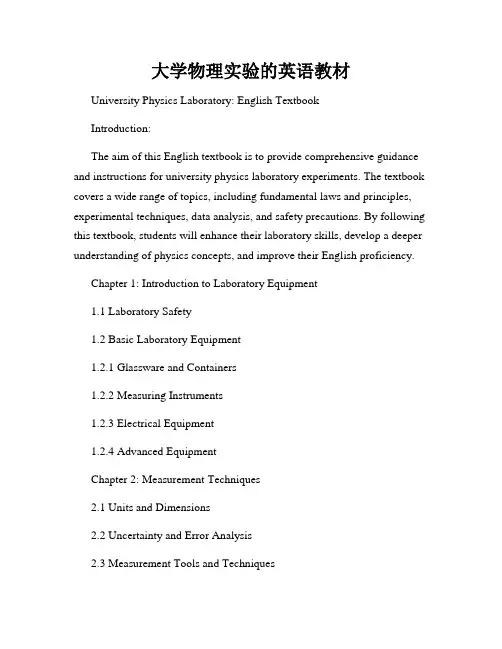
大学物理实验的英语教材University Physics Laboratory: English TextbookIntroduction:The aim of this English textbook is to provide comprehensive guidance and instructions for university physics laboratory experiments. The textbook covers a wide range of topics, including fundamental laws and principles, experimental techniques, data analysis, and safety precautions. By following this textbook, students will enhance their laboratory skills, develop a deeper understanding of physics concepts, and improve their English proficiency.Chapter 1: Introduction to Laboratory Equipment1.1 Laboratory Safety1.2 Basic Laboratory Equipment1.2.1 Glassware and Containers1.2.2 Measuring Instruments1.2.3 Electrical Equipment1.2.4 Advanced EquipmentChapter 2: Measurement Techniques2.1 Units and Dimensions2.2 Uncertainty and Error Analysis2.3 Measurement Tools and Techniques2.3.1 Length Measurement2.3.2 Time Measurement2.3.3 Mass Measurement2.3.4 Temperature Measurement2.3.5 Other Important MeasurementsChapter 3: Experiments on Mechanics3.1 Introduction to Mechanics3.2 Experimental Procedures for Newton's Laws3.2.1 Experiment 1: Force and Motion3.2.2 Experiment 2: Frictional Forces3.3 Experiment on Gravitation3.3.1 Experiment 3: Gravitational Force and Acceleration due to Gravity 3.4 Experiment on Simple Harmonic Motion3.4.1 Experiment 4: Pendulum MotionChapter 4: Experiments on Optics4.1 Introduction to Optics4.2 Experiments on Geometrical Optics4.2.1 Experiment 5: Reflection4.2.2 Experiment 6: Refraction4.3 Experiments on Wave Optics4.3.1 Experiment 7: Interference of Light4.3.2 Experiment 8: Diffraction of LightChapter 5: Experiments on Electricity and Magnetism 5.1 Introduction to Electricity and Magnetism5.2 Experiments on DC Circuits5.2.1 Experiment 9: Ohm's Law and Resistors5.2.2 Experiment 10: Kirchhoff's Laws and DC Circuits 5.3 Experiments on Magnetism and Electromagnetism 5.3.1 Experiment 11: Magnetic Fields and Forces5.3.2 Experiment 12: Electromagnetic Induction Chapter 6: Experiments on Modern Physics6.1 Introduction to Modern Physics6.2 Experiments on Atomic and Nuclear Physics6.2.1 Experiment 13: Radioactivity and Half-Life6.2.2 Experiment 14: Atomic Spectra and Energy Levels 6.3 Experiments on Quantum Mechanics6.3.1 Experiment 15: Wave-Particle Duality6.3.2 Experiment 16: Photoelectric EffectChapter 7: Data Analysis and Error Propagation7.1 Data Collection and Recording7.2 Data Analysis Techniques7.3 Graphing and Curve Fitting7.4 Error Propagation and ReportingChapter 8: Laboratory Reports and Presentation8.1 Structure of a Laboratory Report8.2 Writing Style and Language8.3 Presenting Experimental Results8.4 Peer Review and FeedbackConclusion:This English textbook for university physics laboratory experiments offers a comprehensive guide for students to conduct practical experiments effectively. With a strong emphasis on safety, accurate measurements, data analysis, and clear reporting, the textbook equips students with the necessary skills to excel in the laboratory. By using this textbook, students will enhance their understanding of physics concepts, improve their English proficiency, and become adept researchers in the field of physics.。
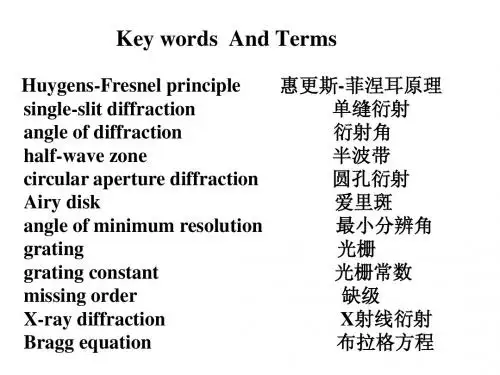
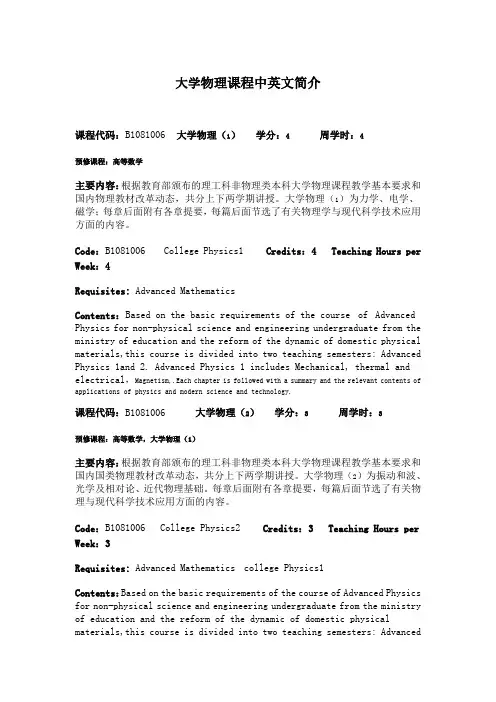
大学物理课程中英文简介课程代码:B1081006大学物理(1)学分:4 周学时:4预修课程:高等数学主要内容:根据教育部颁布的理工科非物理类本科大学物理课程教学基本要求和国内物理教材改革动态,共分上下两学期讲授。
大学物理(1)为力学、电学、磁学;每章后面附有各章提要,每篇后面节选了有关物理学与现代科学技术应用方面的内容。
Code:B1081006College Physics1Credits:4Teaching Hours per Week:4Requisites: Advanced MathematicsContents:Based on the basic requirements of the course of Advanced Physics for non-physical science and engineering undergraduate from the ministry of education and the reform of the dynamic of domestic physical materials,this course is divided into two teaching semesters: Advanced Physics 1and 2. Advanced Physics 1 includes Mechanical, thermal and electrical,Magnetism,.Each chapter is followed with a summary and the relevant contents of applications of physics and modern science and technology.课程代码:B1081006大学物理(2)学分:3 周学时:3预修课程:高等数学,大学物理(1)主要内容:根据教育部颁布的理工科非物理类本科大学物理课程教学基本要求和国内国类物理教材改革动态,共分上下两学期讲授。
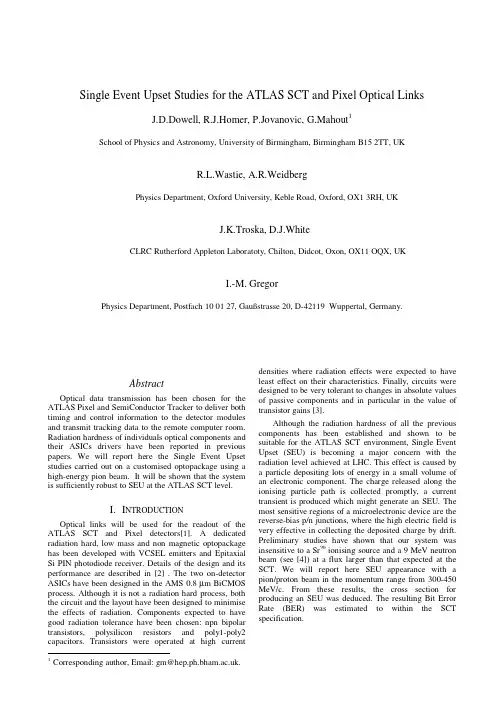
Single Event Upset Studies for the ATLAS SCT and Pixel Optical LinksJ.D.Dowell, R.J.Homer, P.Jovanovic, G.Mahout 1School of Physics and Astronomy, University of Birmingham, Birmingham B15 2TT, UKR.L.Wastie, A.R.WeidbergPhysics Department, Oxford University, Keble Road, Oxford, OX1 3RH, UKJ.K.Troska, D.J.WhiteCLRC Rutherford Appleton Laboratoty, Chilton, Didcot, Oxon, OX11 OQX, UKI.-M. GregorPhysics Department, Postfach 10 01 27, Gaußstrasse 20, D-42119 Wuppertal, Germany.1Corresponding author, Email: gm@.AbstractOptical data transmission has been chosen for the ATLAS Pixel and SemiConductor Tracker to deliver both timing and control information to the detector modules and transmit tracking data to the remote computer room.Radiation hardness of individuals optical components and their ASICs drivers have been reported in previous papers. We will report here the Single Event Upset studies carried out on a customised optopackage using a high-energy pion beam. It will be shown that the system is sufficiently robust to SEU at the ATLAS SCT level.I. I NTRODUCTIONOptical links will be used for the readout of the ATLAS SCT and Pixel detectors[1]. A dedicated radiation hard, low mass and non magnetic optopackage has been developed with VCSEL emitters and Epitaxial Si PIN photodiode receiver. Details of the design and its performance are described in [2] . The two on-detector ASICs have been designed in the AMS 0.8 µm BiCMOS process. Although it is not a radiation hard process, both the circuit and the layout have been designed to minimise the effects of radiation. Components expected to have good radiation tolerance have been chosen: npn bipolar transistors, polysilicon resistors and poly1-poly2capacitors. Transistors were operated at high current densities where radiation effects were expected to have least effect on their characteristics. Finally, circuits were designed to be very tolerant to changes in absolute values of passive components and in particular in the value of transistor gains [3].Although the radiation hardness of all the previous components has been established and shown to be suitable for the ATLAS SCT environment, Single Event Upset (SEU) is becoming a major concern with the radiation level achieved at LHC. This effect is caused by a particle depositing lots of energy in a small volume of an electronic component. The charge released along the ionising particle path is collected promptly, a current transient is produced which might generate an SEU. The most sensitive regions of a microelectronic device are the reverse-bias p/n junctions, where the high electric field is very effective in collecting the deposited charge by drift.Preliminary studies have shown that our system was insensitive to a Sr 90 ionising source and a 9 MeV neutron beam (see [4]) at a flux larger than that expected at the SCT. We will report here SEU appearance with a pion/proton beam in the momentum range from 300-450MeV/c. From these results, the cross section for producing an SEU was deduced. The resulting Bit Error Rate (BER) was estimated to within the SCT specification.II. L INKS S PECIFICATIONSThe SCT links transfer digital data from the SCT modules to the off-detector electronics (RODs) at a rate of 40 Mbits/s and use NRZ coding of the digital readout data, with provision to operate also at 80 Mb/s for potential use within the ATLAS pixel subsystem. Optical links are also used to transfer Timing, Trigger and Control (TTC) data from the RODs to the SCT modules.BiPhase Mark (BPM) encoding is used to send the control data for a module on the same fibre as the 40 MHz bunch crossing clock. In this scheme, a 20 MHz clock is sent and each extra transitions are used to encode “1”s in the data as illustrated schematically in Figure 1.The links are based on radiation-hard VCSELs transmitters and Si PIN photodiodes receivers. The VCSEL will be driven by a simple VCSEL Driver Chip (VDC) which translates LVDS data from the silicon module to the current signal used to drive the optical emitter. The PIN diode signal is received by the DORIC chip. The DORIC chip decodes the BPM encoded input data stream to recover the 40 MhZ clock and 40 Mb/s control data which are output in LVDS format.Single Event Upset is most likely to take the form of spurious signal generation in the PIN photodiode which is decoded by DORIC as an erroneous data bit. DORIC and VDC themselves have been designed to minimise SEU effects by keeping the area of active components small.The epitaxial Si PIN, however, is 350 µm in diameter with an active thickness of 15 µm. The system specification is for a Bit Error Rate (BER) better than 10-9 s -1 which must be maintained at all times during the operation to avoid missing trigger information which would cause modules to lose synchronisation with the rest of the system. As the predominant particles in the SCT during operation will be pions with energies in the several hundred MeV range, a pion beam facility was chosen for the SEU study as described below.III. E XPERIMENTThe pion beamline πM1 at the Paul Scherrer Institut (PSI), Villigen, CH, was used for the Single Event Upset study. It was possible to control the beam momentum in the range 300-465 MeV/c, thus enabling some measurement of the energy dependence of the measured SEU rates. The beams used consisted largely of positive pions (π+), with less than ~20% proton contamination –the ratio depending upon the momentum used. The beam spot at the sample was measured to have FWHM of ~20mm in both transverse directions using a wire chamber. Fluxes were measured using a 2mm diameter disk of scintillator mounted in front of a photomultiplier tube, cross-checked using the activation of Al-foils. Both of the measurements agreed to within 10% which is within the independent measurement accuracy. Both ASICs were mounted on a kapton support structure similar to the final SCT style support along with a custom optical package containing two VCSELs and one epitaxial silicon PIN photodiode. This so-called “dogleg ”was mounted in the beam as shown in figure 2. The beam spot were arranged to cover the area of both ASICs and the optoelectronics components. It can be assumed that the flux was uniform over this area of approximately 10mm ×10mm.A VME-based BER test system was used to measure the BER rate as a function of optical power. A reference data set was taken with no beam followed by data with the beam at various momenta .IV. D ATA R ESULTSData were taken at PSI at four momenta and five particle fluxes as shown in Table 1. The BER is plotted asFigure 1 Bi-Phase mark encoding of TTCdata.Figure 2: Devices mounted onto a “dogleg” for SEU testing at PSI. The beam passed through the center of the package and ASICs into the board.a function of the average photodiode current in Figure 3.There is a clear region where SEUs are observed at low optical input powers. Sufficient headroom is available in the system to allow larger optical signals to be used which swamp the signals produced by particles passing through the photodiode and recover the system BER to the specified level of 10-9s -1. This is encouraging for the final application where the maximum flux in the SCT is not expected to exceed 3 106 cm 2 s -1. At the SCT level, a BER which takes into account SEU could be estimated, as it will be shown in the next paragraph.Table 1: Pion/proton fluxes obtained at different beam momenta in the PSI beam. The pion beam flux was measured with an accurancy better than ~10%,corrected for photomultiplier system dead-time.Beam Momentum Flux (cm -2 s -1)300 MeV/c 2.95 106350 MeV/c 5.71 107405 MeV/c 4.96 106405 MeV/c 1.16 108465 MeV/c1.22 108Figure 3: Measured Bit Error Rate before and during exposure to the PSI beam at various momenta.An upset cross section (σupset ) is calculated from the ratio of the number of errors N err observed in a given interval to the fluence φ in the same time interval:φσerr N upset =The measured σupset is shown in Figure 4. Data for high and low flux at a beam momentum of 405 MeV/c are in agreement indicating a linear scaling with flux and thus allowing these results to be used to scale to different rates that may be encountered in the final application indifferent regions of the detector. One possible expla-nation for the higher BER cross-section at 300 MeV/c is the ∆ resonance in pion-nucleon scattering which gives rise to a marked increase in the total pion-proton interaction cross-section. Detailed Monte Carlo simulations would be needed to verify this.We can scale the additional energy deposit from the passage of a high energy particle through the photodiode from a simple model of DORIC as an RC filter:opin e E lh I E eh ω×+×=−)(1012min where:E min minimum energy deposit required to trigger DORIC (MeV)I pin average photocurrent (µA)lh constant representing the hysteresis in DORIC4A (10)E eh mean energy required to create an electron-hole pair in silicon (3.6 eV)e elementary charge (1.6x10-19 C)0ω =RC1(109 s -1) time constant of the DORIC input stageFigure 4:Measured SEU cross-section for the differentbeam momenta available at PSI.The energy necessary to trigger a bit-flip in DORIC for a 30µA input photocurrent is of 0.6 MeV, up to 3.6MeV at 100 µA.V. E STIMATED BER WITH THE SCT FLUXProvision has been made in order to deliver at the system level an input power level of 1mW. The loss introduced by the patch panel, added to the loss due to the radiation damage in the fibre, could be estimated of 4 dB.The PIN photodiode responsivity, estimated to be 0.3A/W after 10 years of irradiation, gives a minimal inputcurrent of100µA.For such a value,the measured cross-section will be610-9cm2.With a SCT flux of 3106n cm2s-1and a data rate of40Mbit/s,we obtain an estimated BER of610-10(±1.710-10)s-1,lower than the 10-9SCT BER specification.VI.CONCLUSION SOn-detector components of the data links have been proven to be sufficiently radiation hard for use in the SCT.System testing in a pion beam of similar intensity to the flux levels expected in the SCT have shown that the data links can be operated in a regime where the effect of SEU can be minimised by choosing a sufficiently high input power level.VII.A CKNOWLEDGEMENTSWe acknowledge financial help from the UK Particle Physics and Astronomy Research Councils.We thank Ian McGill,Dennis Grant and Roger Harris(Birmingham University)for help in the preparation of samples.PSI beam coordinator Dieter Renker and Konrad Dieters are thanked for help in setting up at PSI,while PSI radiation protection staff are thanked for help with dosimetry. M.Huhtinen of CERN is thanked for stimulating discussions on the physical interpretation of the results and their simulation.References1. D.G.Charlton et al.,Nucl.Instr.Meth.A443(2000)430.2. A.R.Weidberg and al.,Radiation Hard Optical Linksfor the ATLAS SCT and Pixel Detectors,these proceeding.3. D.J.White and al.,Radiation Hardness Studies of theFront-end ASICs for the Optical Links of the ATLAS SemiConductor Tracker,Nucl.Instr.and Meth.(in print)4.G.Mahout and al.,Radiation Hard Optical Links forthe ATLAS SCT and Pixel detectors,proceedings of LEB99Colorado5.See www at url:/~weidberg/fluences .html6.J.D.Dowell et al.,Radiation Hardness and LifetimeStudies of the Photodiodes for the Optical Readout of the ATLAS SCT.Accepted for publication in Nucl.Instr.Meth.A.7.See www at url:http://www.atlas.uni-wuppertal.de/optolink/wuppertal/annealing.html.8.Radiation Hardness Studies of the Front-end ASICsfor the Optical Links of the ATLAS SemiConductor Tracker.Accepted for publication in Nucl.Instr.Meth.A.9.G.Mahout et al,Nucl.Instr.Meth.A446(2000)426.。
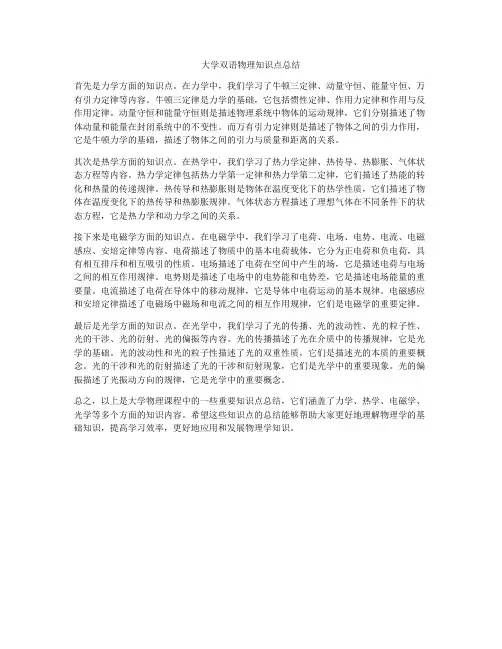
大学双语物理知识点总结首先是力学方面的知识点。
在力学中,我们学习了牛顿三定律、动量守恒、能量守恒、万有引力定律等内容。
牛顿三定律是力学的基础,它包括惯性定律、作用力定律和作用与反作用定律。
动量守恒和能量守恒则是描述物理系统中物体的运动规律,它们分别描述了物体动量和能量在封闭系统中的不变性。
而万有引力定律则是描述了物体之间的引力作用,它是牛顿力学的基础,描述了物体之间的引力与质量和距离的关系。
其次是热学方面的知识点。
在热学中,我们学习了热力学定律、热传导、热膨胀、气体状态方程等内容。
热力学定律包括热力学第一定律和热力学第二定律,它们描述了热能的转化和热量的传递规律。
热传导和热膨胀则是物体在温度变化下的热学性质,它们描述了物体在温度变化下的热传导和热膨胀规律。
气体状态方程描述了理想气体在不同条件下的状态方程,它是热力学和动力学之间的关系。
接下来是电磁学方面的知识点。
在电磁学中,我们学习了电荷、电场、电势、电流、电磁感应、安培定律等内容。
电荷描述了物质中的基本电荷载体,它分为正电荷和负电荷,具有相互排斥和相互吸引的性质。
电场描述了电荷在空间中产生的场,它是描述电荷与电场之间的相互作用规律。
电势则是描述了电场中的电势能和电势差,它是描述电场能量的重要量。
电流描述了电荷在导体中的移动规律,它是导体中电荷运动的基本规律。
电磁感应和安培定律描述了电磁场中磁场和电流之间的相互作用规律,它们是电磁学的重要定律。
最后是光学方面的知识点。
在光学中,我们学习了光的传播、光的波动性、光的粒子性、光的干涉、光的衍射、光的偏振等内容。
光的传播描述了光在介质中的传播规律,它是光学的基础。
光的波动性和光的粒子性描述了光的双重性质,它们是描述光的本质的重要概念。
光的干涉和光的衍射描述了光的干涉和衍射现象,它们是光学中的重要现象。
光的偏振描述了光振动方向的规律,它是光学中的重要概念。
总之,以上是大学物理课程中的一些重要知识点总结,它们涵盖了力学、热学、电磁学、光学等多个方面的知识内容。
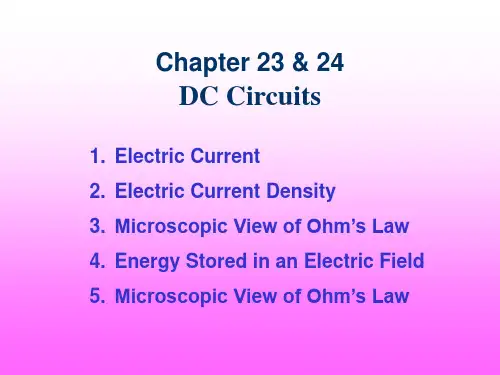
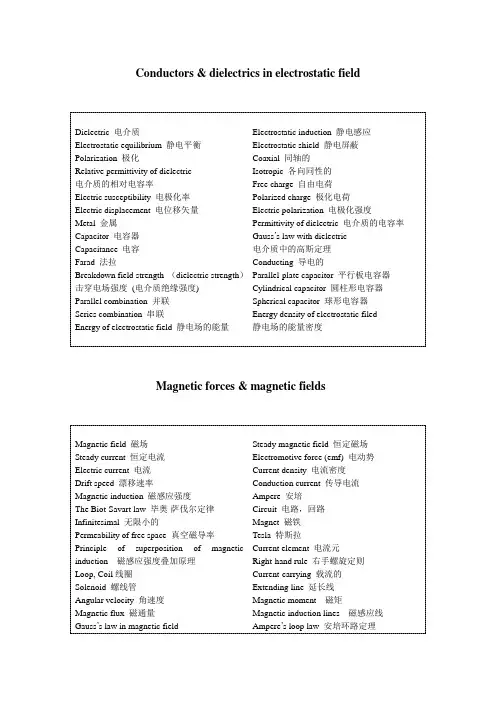
Conductors & dielectrics in electrostatic fieldDielectric 电介质 Electrostatic equilibrium 静电平衡 Polarization 极化 Relative permittivity of dielectric 电介质的相对电容率 Electric susceptibility 电极化率 Electric displacement 电位移矢量 Metal 金属 Capacitor 电容器 Capacitance 电容 Farad 法拉 Breakdown field strength (dielectric strength) 击穿电场强度 (电介质绝缘强度) Parallel combination 并联 Series combination 串联 Energy of electrostatic field 静电场的能量Electrostatic induction 静电感应 Electrostatic shield 静电屏蔽 Coaxial 同轴的 Isotropic 各向同性的 Free charge 自由电荷 Polarized charge 极化电荷 Electric polarization 电极化强度 Permittivity of dielectric 电介质的电容率 Gauss’s law with dielectric 电介质中的高斯定理 Conducting 导电的 Parallel-plate capacitor 平行板电容器 Cylindrical capacitor 圆柱形电容器 Spherical capacitor 球形电容器 Energy density of electrostatic filed 静电场的能量密度Magnetic forces & magnetic fieldsMagnetic field 磁场 Steady current 恒定电流 Electric current 电流 Drift speed 漂移速率 Magnetic induction 磁感应强度 The Biot-Savart law 毕奥-萨伐尔定律 Infinitesimal 无限小的 Permeability of free space 真空磁导率 Principle of superposition of magnetic induction 磁感应强度叠加原理 Loop, Coil 线圈 Solenoid 螺线管 Angular velocity 角速度 Magnetic flux 磁通量 Gauss’s law in magnetic fieldSteady magnetic field 恒定磁场 Electromotive force (emf) 电动势 Current density 电流密度 Conduction current 传导电流 Ampere 安培 Circuit 电路,回路 Magnet 磁铁 Tesla 特斯拉 Current element 电流元 Right-hand rule 右手螺旋定则 Current-carrying 载流的 Extending line 延长线 Magnetic moment 磁矩 Magnetic induction lines 磁感应线 Ampere’s loop law 安培环路定理磁场中的高斯定理 Clockwise 顺时针的 Anticlockwise (counterclockwise) 逆时针的 Ideal 理想的 Closed path 闭合路径 Turn 匝,圈 Lorentz force 洛伦兹力 Ampere force 安培力 period 周期 Ampere law 安培定律 Torque 转矩 Magnetization 磁化Rectangle 长方形的 Cross section 截面 Toroid 螺绕环 Closely spaced 密绕的 Magnetic medium 磁介质 Ampere’s loop law in magnetic medium 磁介质中的安培环路定理 Magnetic permeability 磁导率 Relative magnetic permeability 相对磁导率 Magnetization intensity 磁化强度 Magnetization current 磁化电流 Magnetic field intensity 磁场强度Faraday’s law & inductanceFaraday’s law of induction 法拉第电磁感应定律 Induction electromotive force 感应电动势 Magnetic flux linkage 磁链 Vary 变化 Motional electromotive force 动生电动势 Bar 棒 Pivot 支点 Induced electric field 感生电场 Mutual inductance electromotive force 互感电动势 Henry 亨利 Energy of magnetic field 磁场的能量 Energy density of magnetic field 磁场的能量密度 Cable 电缆 Displacement current 位移电流 Full current 全电流Induction current 感应电流 Lenz’s law 楞次定律 Move away from 离开 Upwards 向上 Downwards 向下 Induced electromotive force 感生电动势 Electromagnetic field 电磁场 Self-inductance electromotive force 自感电动势 Self-inductance 自感 Mutual-inductance 互感 Volume element 体积元 Displacement current density 位移电流密度 Ampere’s loop law in full current 全电流安培环路定理 Maxwell electromagnetism theorem 麦克斯韦电磁场理论 Maxwell’s equations 麦克斯韦方程组。
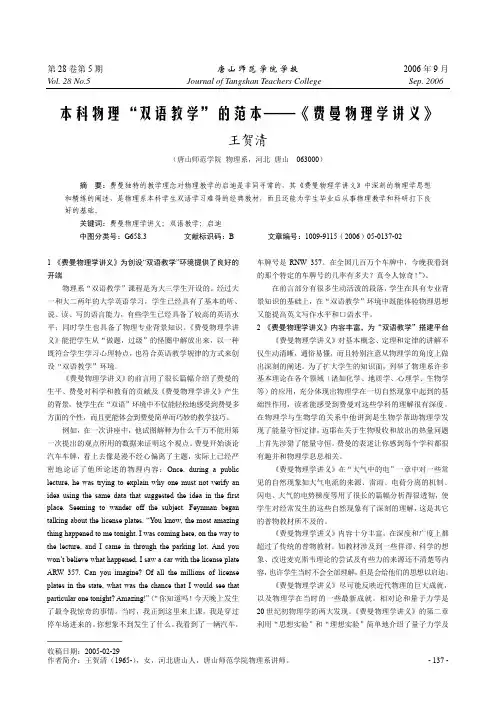
第28卷第5期 唐山师范学院学报 2006年9月 Vol. 28 No.5 Journal of Tangshan Teachers College Sep. 2006 ────────── 收稿日期:2005-02-29作者简介:王贺清(1965-),女,河北唐山人,唐山师范学院物理系讲师。
- 137 -本科物理“双语教学”的范本——《费曼物理学讲义》王贺清(唐山师范学院 物理系,河北 唐山 063000)摘 要:费曼独特的教学理念对物理教学的启迪是非同寻常的,其《费曼物理学讲义》中深刻的物理学思想和精练的阐述,是物理系本科学生双语学习难得的经典教材,而且还能为学生毕业后从事物理教学和科研打下良好的基础。
关键词:费曼物理学讲义;双语教学;启迪中图分类号:G658.3 文献标识码:B 文章编号:1009-9115(2006)05-0137-021 《费曼物理学讲义》为创设“双语教学”环境提供了良好的开端物理系“双语教学”课程是为大三学生开设的。
经过大一和大二两年的大学英语学习,学生已经具有了基本的听、说、读、写的语言能力,有些学生已经具备了较高的英语水平;同时学生也具备了物理专业背景知识。
《费曼物理学讲义》能把学生从“做题,过级”的怪圈中解放出来,以一种既符合学生学习心理特点,也符合英语教学规律的方式来创设“双语教学”环境。
《费曼物理学讲义》的前言用了很长篇幅介绍了费曼的生平、费曼对科学和教育的贡献及《费曼物理学讲义》产生的背景,使学生在“双语”环境中不仅能轻松地感受到费曼多方面的个性,而且更能体会到费曼简单而巧妙的教学技巧。
例如,在一次讲座中,他试图解释为什么千万不能用第一次提出的观点所用的数据来证明这个观点。
费曼开始谈论汽车车牌,看上去像是漫不经心偏离了主题,实际上已经严密地论证了他所论述的物理内容:Once, during a public lecture, he was trying to explain why one must not verify an idea using the same data that suggested the idea in the first place. Seeming to wander off the subject. Feynman began talking about the license plates. “You know, the most amazing thing happened to me tonight. I was coming here, on the way to the lecture, and I came in through the parking lot. And you won’t believe what happened. I saw a car with the license plate ARW 357. Can you imagine? Of all the millions of license plates in the state, what was the chance that I would see that particular one tonight? Amazing!”(“你知道吗!今天晚上发生了最令我惊奇的事情。
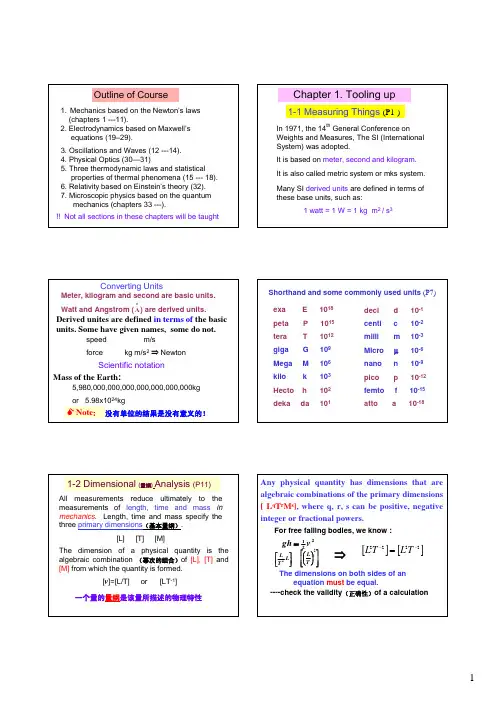
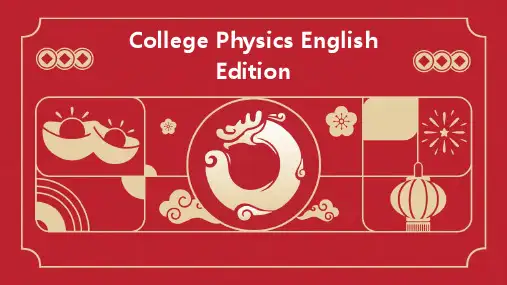
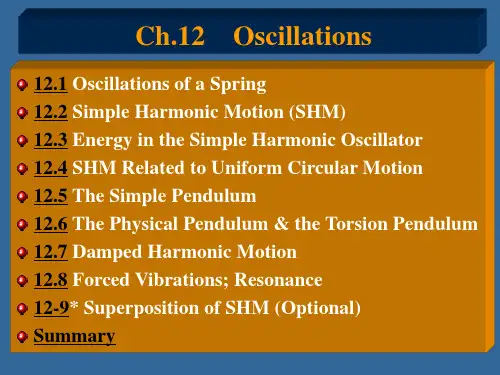
大学物理英汉词汇对照1、mechanical motion 机械运动2、theory of relativity 相对论3、particl 质点4、frame of reference 参照系5、position vector 位置矢量6、equation of motion 运动方程7、orbit 轨道8、distance 路程9、displacement 位移10、velocity 速度11、acceleration 加速度12、tangential acceleration 切向加速度13、normal acceleration 切向加速度14、Newton's law of motion 牛顿运动定律15、inertia 惯性16、force 力17、moment of force 力矩18、Galileo transformation 伽利略变换19、system 系统20、work 功21、kinetic energy 动能22、potential energy 势能23、mechanical energy 机械能24、momentum 动量25、angular momentum 角动量26、Lorentz transformation 洛仑兹变换27、mol 摩尔28、atmospheric pressure 大气压29、standard condition 标准状况30、ideal gas 理想气体31、gas constant 气体常数32、Avogadro’s number阿伏伽德罗数33、distribution function of speed 速率分布函数34、most probable speed 最概然速率35、average speed 平均速率36、root-mean-square speed 方均根速率37、degree of freedom 自由度38、diatomic molecule 双原子分子39、polyatomic molecule 多原子分子40、theorem of equipartition of energy 能量均分定理41、collision frequency 碰撞频率42、free path 自由程43、temperature 温度44、electromagnetism 电磁学45、electric field 电场46、magnetic field 磁场47、electromagnetic field 电磁场48、electromagnetic wave 电磁波49、Maxwell’s equations麦克斯韦方程组50、electromagnetic energy 电磁能量51、energy of electric field 电场能量52、energy of magnetic field 磁场能量53、Poynting’s vector坡印廷矢量54、energy flow density 能流密度55、Lorentz force 洛伦兹力56、electron 电子57、electron theory 电荷58、point charge 点电荷59、charge density 电荷密度60、conservation law of charge 电荷守恒定律61、bound charge 束缚电荷62、free charge 自由电荷63、conductor 导体64、insulator 绝缘体65、dielectric 电介质66、C oulomb’s law库仑定律67、electrostatic field 静电场68、electric field strength 电场强度69、electric flux 电通量70、Gauss’s law高斯定理71、electric potential 电势72、electric potential difference 电势差73、equipotential surface 等势面74、electrostatic induction 静电感应75、induced charge 感生电荷76、electrostatic shielding 静电屏蔽77、electrostatic equilibrium 静电平衡78、capacitance 电容79、electric source 电源80、non-electrostatic force 非静电力81、electromotive force 电动势82、magnetostatic field 静磁场83、magnetic induction 磁感应强度83、magnetic field strength 磁场强度85、uniform magnetic field 均匀磁场86、magnetic induction flux 磁感应通量87、Ampere’s force安培力88、Hall effect 霍耳效应88、paramagnetic substance 顺磁质89、diamagnetic substance 抗磁质90、superconductivity 超导性91、ferromagnetic substance 铁磁质92、electromagnetic induction 电磁感应93、Faraday’s electromagnetic induction law 法拉第电磁感应定律94、induced electromotive force 感生电动势95、motional electromotive force 动生电动势96、(1)self induction (2)self inductance 自感97、(1)mutual induction (2)mutual inductance 互感98、eddy current 涡电流99、displacement current 位移电流100、electromagnetic oscillation 电磁振荡101、electromagnetic spectrum 电磁波谱102、electromagnetic theory of light 光的电磁理论103、Hertz’s experiment赫兹实验104、coulomb 库仑105、volt 伏特106、ohm 欧姆107、reciprocal ohm 姆欧108、siemens 西门子109、ampere 安培110、farad 法拉111、henry 亨利112、weber 韦伯113、vibration(vibration motion oscillation)振动114、harmonic oscillation 谐振动115、damped oscillation 阻尼振动116、forced oscillation 受迫振动117、linear oscillation 线性振动118、mechanical oscillation 机械振动119、thermal oscillation 热振动120、light oscillation 光振动121、period 周期122、frequency 频率123、amplitude 振幅124、phase 相位125、synthesis 合成126、rotating vector 旋转矢量127、wave 波动128、superposition 迭加129、mechanical wave 机械波130、electromagnetic ware 电磁波131、longitudinal waves 纵波132、transversal waves 横波133、ware surface 波面134、ray 波线135、wave front 波前136、wave speed 波速137、plane wave平面波138、spherical waves 球面波139、harmonic waves 简谐波140、wave function 波函数141、wavelength 波长142、wave number 波数143、interference 干涉144、coherent wave 相干波145、constructive interference 相长干涉146、destructive interference 相消干涉147、geometrical optics 几何光学148、modern optics 现代光学149、physical optics 物理光学150、wave optics 波动光学151、quantum optics 量子光学152、nonlinear optics 非线性光学153、applied optics 应用光学154、information optics 信息光学155、Fourier optics 傅里叶光学156、index of refraction 折射率157、photo vector 光矢量158、speed of light 光速159、Young’s two-slit interference 扬氏双缝干涉160、equal inclination interference 等倾干涉161、equal thickness interference 等厚干涉162、film interference 薄膜干涉163、diffraction 衍射164、Fresnel diffraction 菲涅尔衍射165、Fraunhofer diffraction 夫琅和费衍射166、Huygens-Fresnel principle 惠更斯-菲涅尔原理167、Single slit diffraction 单缝衍射168、Double slit diffraction 双缝衍射169、Circular hole diffraction 圆孔衍射170、X-ray diffraction X射线171、Electron diffraction 电子衍射172、Rayleigh criterion 瑞利判据173、grating 光栅174、grating constant 光栅常数175、grating spectrum 光栅光谱176、natural light(natural daylight)自然光177、polarized light 偏振光178、linearly polarized light 线偏振光151、partially polarized light 部分偏振光179、Malus law 马吕斯定律180、birefringence(double refraction)双折射181、ordinary light 寻常光182、extraordinary light 非寻常光184、thermal radiation 热辐射(heat radiation)(calorific radiation)184、black-body radiation 黑体辐射185、Planck’s qua ntum theory 普朗克量子论186、photo-electric effect 光电效应187、light quantum 光(量)子188、Compton effect 康普顿效应189、Compton wave lenghth 康普顿波长190、atomic structure 原子结构191、Bohr’s quantum theory 玻尔量子论192、Bohr radius 玻尔半径193、matter wave 物质波194、microscopic world 微观世界195、macroscopic world 宏观世界196、wave-particle duality 波粒二象性197、quantum physics 量子物理学198、length 长度199、mass 质量200、time 时间201、electric current 电流202、thermodynamic temperature 热力学温度203、amount of substance 物质的量204、luminous intensity 发光强度205、plane angle 平面角206、solid angle 立体角Prefixes Used With SI Units国际单位制使用的词头exa—艾E(1018)peta—拍P(1015)tera—太T(1012)giga—吉G(109)mega—兆M(106)kilo—千K(103)hecto—白h(102)deca—十da(10)deci—分d(10-1)centi—厘c(10-2)milli—毫m(10-3)micro—微μ(10-6)nano—纳n(10-9)pico—皮p(10-12)femto—飞f(10-15)affo—阿a(10-18)。
大学物理课程的双语教学之初探【摘要】本文旨在探讨大学物理课程的双语教学。
首先介绍了双语教学的背景和研究目的。
接着分析了双语教学在大学物理课程中的优势和应用。
然后详细探讨了教学模式,并通过案例分析和学生反馈验证了双语教学的有效性。
最后总结了双语教学对大学物理课程的影响,并展望了未来研究方向。
通过本文的研究,有望为大学物理教学提供新的思路和方法,促进学生的学习和发展。
【关键词】大学物理课程、双语教学、优势、应用、教学模式、案例分析、学生反馈、影响、未来研究方向1. 引言1.1 背景介绍随着全球化的发展和国际化教育的兴起,双语教学在中国的大学课堂中渐渐受到重视。
大学物理课程作为重要的基础课程,其双语教学也逐渐引起了教育界的关注。
在传统的大学物理教学中,教师通常使用母语进行授课,而学生则需要通过母语来理解和消化所学内容。
但是随着社会的多元化和国际化程度的加深,学生们对英语的需求也越来越强烈,因此采用双语教学模式来教授大学物理课程具有重要的现实意义。
双语教学不仅可以帮助学生提高英语水平,更可以拓宽学生的视野,加强他们的跨文化沟通能力。
通过将英文与物理知识相结合,不仅可以增加学生的学习兴趣,还可以帮助他们更好地理解抽象的物理概念。
对于大学物理教学而言,探索双语教学的有效策略和方法具有重要的意义。
1.2 研究目的研究目的是探讨在大学物理课程中采用双语教学的可行性和效果,分析双语教学对学生学习物理知识的影响。
通过对双语教学的优势、应用、教学模式、案例分析和学生反馈的深入探讨,旨在总结出双语教学对大学物理课程的积极影响和不足之处,为提升物理教育质量提供理论支持和实践参考。
本研究旨在为如何更好地融合双语教学和大学物理课程提供借鉴,为教育教学改革提供有益启示。
通过本研究的探讨,希望挖掘出双语教学在大学物理课程中的潜力,探索更加有效的教学方法和策略,推动教育教学的创新发展,提升学生的学习体验和教学质量。
2. 正文2.1 双语教学的优势双语教学的优势在于能够提供更广阔的学习视野和更深入的理解。
《大学物理》课程中英文简介College Physics课程代码:080013B Course Code:080013B课程名称:大学物理Course Name:College Physics学时:48 Periods:48学分:3 Credits:3考核方式:考查Assessment:Inspection先修课程:高等数学Preparatory Courses:Advanced Mathematics物理学是研究物质的基本结构、基本运动形式、相互作用的自然科学。
它的基本理论和研究方法渗透在自然科学的各个领域,是其他自然科学的基础。
以物理学基础为内容的大学物理课,是应用数学专业学生一门重要的通识性必修基础课。
本课程所教授的基本概念、基本理论和基本方法是学生科学素养的重要组成部分,在人才的科学素质培养中具有重要的地位,具有其他课程不能替代的重要作用。
通过本课程的教学,使学生能够掌握力学、热学、电磁学、波动与光学、近代物理学等基本理论知识,为学生毕业后所从事专业技术、管理及科学研究工作打下一定的基础。
Physics is a discipline of natural science which studies the basic structure, the basic movement form and the interaction of matters. Its elementary theories and research methods are the foundation of other natural sciences, which are widely used in all the domains of natural science.College Physics, which takes the foundation of basic physics as its main contents, is one of the compulsory basic courses for the students of mathematics and applied mathematics. The basic concepts, theories and essential methods of the course are an importa nt part of students’ scientific accomplishment and play an important role in improving talented people's scientific quality, which cannot be substituted by other courses.This course enables students to grasp the elementary knowledge of mechanics, thermodynamics, electromagnetism, wave and optics and modern physics. It provides a basis for the work they will do after graduation in the fields of technology, management and scientific research.《普通物理学及实验I》课程中英文简介General Physics and Experiments I课程代码:080024A/080023A Course Code:080024A/080023A课程名称:普通物理学及实验I Course Name:General Physics and Experiment I学时:64/48 Periods:64/48学分:4/3 Credits:4/3考核方式:考试Assessment:Examination先修课程:高等数学Preparatory Courses:Advanced Mathematics物理学是研究物质的基本结构、基本运动形式、相互作用的自然科学。
Teaching Design for College Physics Concise TutorialSecond Edition in English1. IntroductionCollege Physics Concise Tutorial Second Edition in English is a textbook designed for college students majoring in physics. It ms to introduce the fundamental concepts and principles of physics to students in a clear and concise manner. This teaching design is based on this textbook and is designed for a course with a duration of one semester.2. Course ObjectivesThe objectives of this course are:•To help students understand the concepts and principles of physics;•To develop students’ problem-solving skills in physics;•To cultivate students’ interest in physics and scientific research.3. Course OutlineWeek 1-2: Introduction to Mechanics•Introduction to SI units, vectors, and kinematics;•Newton’s laws of motion, work, and energy;•Conservation of energy and momentum.Week 3-4: Heat and Thermodynamics•Temperature, heat, and thermodynamics;•The laws of thermodynamics;•Entropy and the Carnot cycle.Week 5-6: Waves and Optics•Simple harmonic motion;•Wave motion, sound waves;•Geometrical optics, interference, diffraction, and polarization.Week 7-8: Electromagnetism•Electric charge, Coulomb’s law, and electric field;•Gauss’s law, electric potential, and capacitance;•E lectric current, resistance, and Ohm’s law;•Magnetism, Faraday’s law, and electromagnetic induction. Week 9-10: Modern Physics•Special relativity;•Quantum mechanics;•Nuclear physics and particle physics.4. Teaching MethodsThe teaching methods employed in this course are:•Lectures: In-class lectures will be used to introduce new concepts and principles of physics. Students should take notes and participate in discussions.•Problem-solving sessions: Students will be assigned problems to solve, and the solutions will be discussed in class.•Laboratory experiments: Students will conduct laboratory experiments to demonstrate the principles of physics and learnexperimental techniques.•Group discussions: Students will discuss physics-related topics in groups to develop communication and teamwork skills.5. AssessmentThe assessment of this course is composed of the following components:•Mid-term exam: This exam covers the first five weeks of the course. It includes multiple-choice questions and problem-solving questions.•Final exam: This exam covers the entire course and includes multiple-choice questions and problem-solving questions.•Lab reports: Students will submit lab reports for the laboratory experiments conducted in the course.•Homework: Students will be assigned homework problems to be solved and submitted.•Participation: Students will be evaluated based on their participation in lectures, problem-solving sessions, and groupdiscussions.6. ConclusionCollege Physics Concise Tutorial Second Edition in English is an excellent textbook for college students majoring in physics. This teaching design is med at helping students achieve the course objectivesand develop problem-solving skills, interest, and scientific research skills in physics through various teaching methods.。